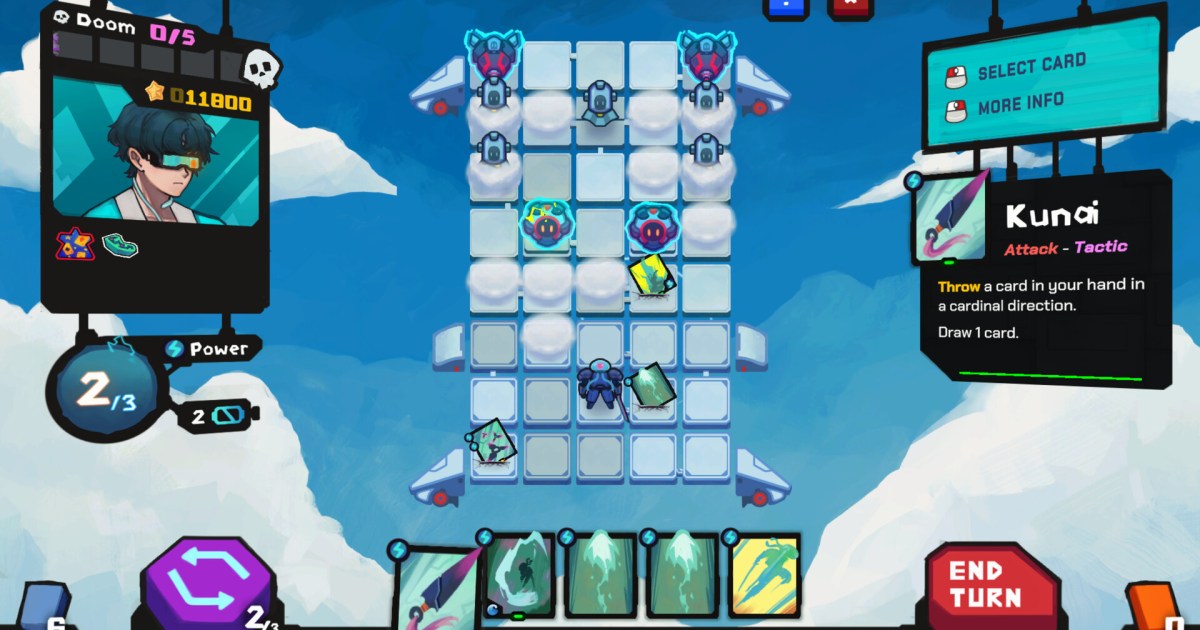There are few games that feel truly timeless to me, but Space Invaders ranks high on that list. Anytime I play it, I still find that I can sink my teeth into it more than most modern games 10,000 times its size. It’s simple, but I find that there’s hidden depth in its strategy. What’s the most efficient way to clear waves? How do you manage columns of aliens once they start getting closer? Every game is a battle in which every shot counts.
StarVaders understands that idea and takes it to a logical evolution. The new indie game is another in a long line of genre hybrids that smashes a roguelike, deck-builder, and shoot-em-up together. I rolled my eyes when I first heard the description, but after a week of toying around with it, I’m hooked. StarVaders takes the feeling I get when playing Space Invaders and successfully puts it into a turn-based tactics format that has me constantly starting one more run.
The premise here is familiar: Aliens have come to Earth! Shocking, I know. It’s up to a squad of mech pilots to fight them off. It’s a simple setup, but there’s some surprising depth to where it all goes. At the end of each run, I hear a bit of cryptic dialogue that peels back what exactly happened more and more. I haven’t seen enough of it yet to know exactly what’s going on, but it adds some narrative intrigue to an already sticky roguelike hook.
Gameplay is the focus here and I’m finding even more depth there with each run. StarVaders plays like a cross between Into the Breach and Space Invaders. In each level, I’m placed on a grid-based board. I’m at the bottom and different alien ships drop in from the top. They come closer to the bottom with each passing turn. If they get into the bottom three rows before I can squash them, they add a tick to my doom meter. When I accumulate five doom, my run ends.
To take down the ships before that happens, I need to play cards. My deck is divided between attacks and movement, and each one costs a bit of heat. Each turn, I must move and shoot to manage the board, all while remembering the unique properties of every alien. I might need to shoot one twice to break its shield first or deal with bugs that move twice as many spaces on a turn. A successful round is a juggling act where I need to make sure I’m not wasting a single action. It’s very much like Into the Breach in that sense, playing on that game’s Chess-like approach combat.
The more I play, the more depth I find in that hook. Following in the footsteps of games like Monster Train, I have a chance to buff my deck and gain passive relics between rounds. I can upgrade cards occasionally too, letting me turn basic cards into essential tools. For instance, I can make it so a basic movement ends with me shooting a bullet upwards, or making it so a quick shot will gain a repeat status effect if it kills an enemy. It takes me a bit to get the hang of every status effect and what they all mean, but my runs become much more efficient once I do. With the right cards, I can clear out a full board of enemies with only a few well-played cards.
There’s a lot of smart risk that goes into that strategy too. Each turn, I only have three heat to work with. Once I hit that limit, I’m in danger of overheating. That means that I can play one more card, but it will be burned and made unusable until the next round. Similarly, there’s also some risk taking when it comes to evading enemy attacks. On each turn, I can see red spaces that my foes will hit once my turn ends. I can spend movement cards to get to safety, or I can intentionally take the hit. If I do, I’ll add a junk card into my deck which I’ll have to spend heat to purge if I don’t want to keep it in my draw. There are a lot of cases where that risk is worth it so long as I have a good handle on my deck and what it can do.
I’m still early in my playthrough, but I’ve found a wealth of deckbuilding strategies to toy around with as I weigh those risks. Some of my builds have been based around intentionally purging cards from my hand to get extra heat. I’ve built others around laying bombs all over the board and shooting to detonate them. There are several characters to unlock across three classes, each of which has their own specific skills, and I unlock new cards each time I level up in a meta progression system. With more difficulties still to unlock and story to see, StarVaders is a game I know I’ll return to a lot this year. It feels like I can pick up a little more strategy with each run, and that’s what really makes it feel like a game built in the spirit of Space Invaders even more than its aliens.
StarVaders is available now on PC.
Read the full article here















